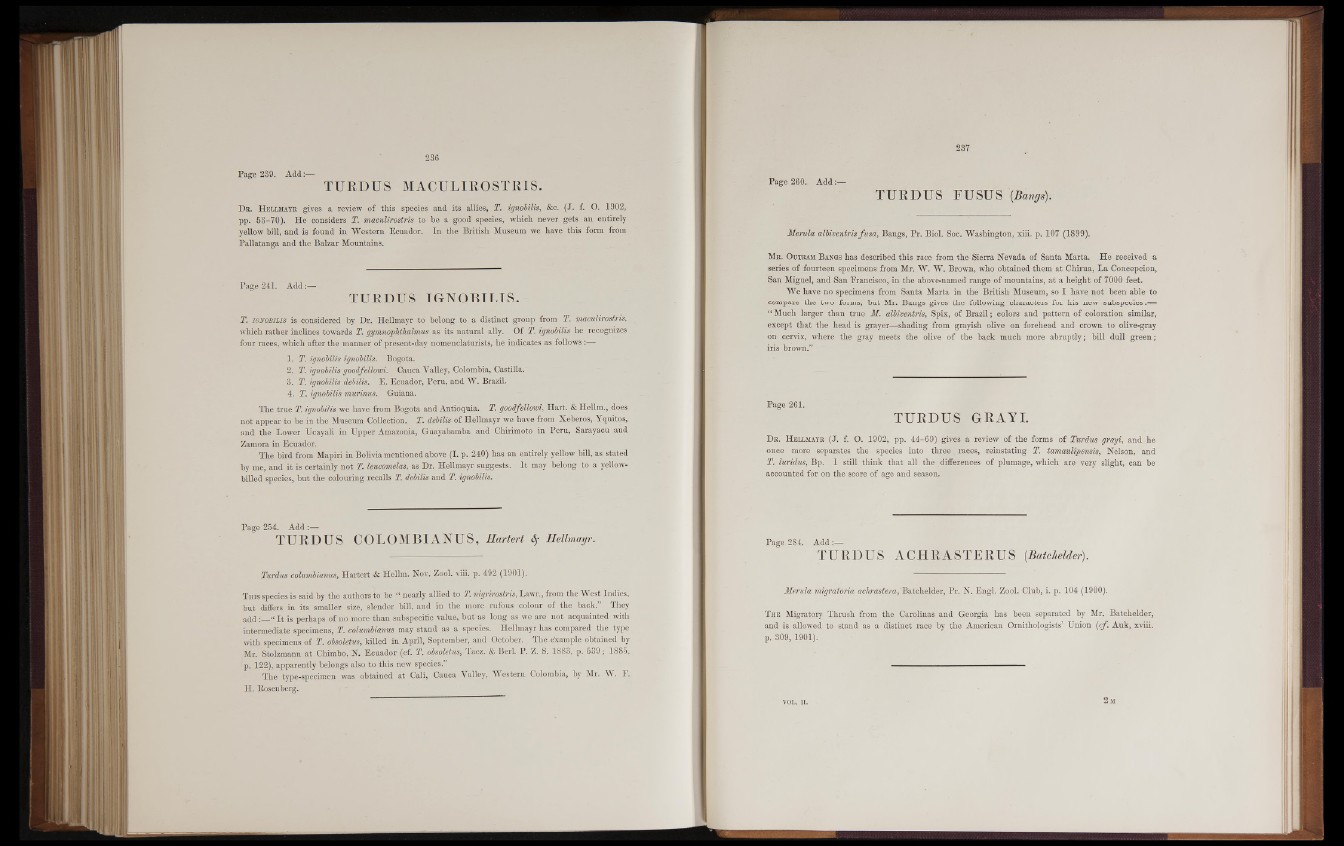
T U R D U S MA C U L IRO S T R I S .
D r. H ellmayr gives a review of this species and its allies, T. ignobilis, &c. (J. f. O. 1902,
pp. 53-70). He considers T. maculirostris to be a good species, which never gets an entirely
yellow bill, and is found in Western Ecuador. In the British Museum we have this form from
Pallatanga and the Balzar Mountains.
Page 241. Add:—
T U R D U S IG N O B I L I S .
T. ignobilis is considered by Dr. Hellmayr to belong to a distinct group from T. maculirostris,
which rather inclines towards T. gymnophthalmus as its natural ally. Of T. ignobilis he recognizes
four races, which after the manner of present-day nomenclaturists, he indicates as f©l|0ws
1. T. ignobilis ignobilis. Bogota.
2. T. ignobilis goodfellowi. Cauca Valley, Colombia, Castilla.
3. T. ignobilis debilis. E. Ecuador, Peru, and W. Brazil.
4. T. ignobilis murinus. Guiana.
The true T. ignobilis we have from Bogota and Antioquia. T. goodfellowi, Hart. & Hellm., does
not appear to be in the Museum Collection. T. debilis of Hellmayr we have from Xeberos, Yquitos,
and the Lower Ucayali in Upper Amazonia, Guayabamba and Chirimoto in Peru, Sarayacu and
Zamora in Ecuador.
The bird from Mapiri in Bolivia mentioned above (I. p. 240) has an entirely yellow bill, as stated
by me, and it is certainly not T. leucomelas, as Dr. Hellmayr suggests. I t may belong to a yellowbilled
species, but the colouring recalls T. debilis and T. ignobilis.
Page 254. Add
T U R D U S C O L OMB IA N U S , Hartert Sf Hellmayr.
Turdus columbianus, Hartert & Hellm. Nov. Zool. viii. p. 492 (1901).-
T his species is said by the authors to be “ nearly allied to T. nigrirostris, Lawr., from the West Indies,
but differs in its smaller size, slender bill, and in the more rufous colour of the back.” They
a d d “ I t is perhaps of no more than subspecific value, b u t as long as we are not acquainted with
intermediate specimens, T. columbianus may stand as a species. Hellmayr has compared the type
with specimens of T. obsoletus, killed in April, September, and October. The example obtained by
Mr. Stolzmann at Chimbo, N. Ecuador (cf. T. obsoletus, lacz. & Berl. P. Z. S. 1883, p. 539; 1885,
-p. 122), apparently belongs also to this new species.”
The type-specimen was obtained at Cali, Cauca Valley, Western Colombia, by Mr. TV. 1.
H. Rosenberg.
Page 260. Add:—
T U R D U S FU SU S {Bangs).
Merula albiventris fusa, Bangs, Pr. Biol. Soc. Washington, xiii. p. 107 (1899).
Mr. O utram B angs has described this race from the Sierra Nevada of Santa Marta. He received a
series of fourteen specimens from Mr. W. W. Brown, who obtained them at Chirua, La Concepcion,
San Miguel, and San Francisco, in the above-named range of mountains, at a height of 7000 feet.
We have no specimens from Santa Marta in the British Museum, so I have not been able to
compare the two forms, but Mr. Bangs gives the following characters for his new subspecies:—
“ Much larger than true M. albiventris, Spix, of Brazil; colors and pattern of coloration similar,
except that the head is grayer—shading from grayish olive on forehead and crown to olive-gray
on cervix, where the gray meets the olive of the back much more abruptly; bill dull green;
iris brown.”
Page 261.
T U R D U S G R A Y I.
Dr. H ellmayr (J. f. O. 1902, pp. 44-69) gives a review of the forms of Turdus grayi, and he
once more separates the species into three races, reinstating T. tamaulypensis, Nelson, and
T. luridus, Bp. I still think that all the differences of plumage, which are very slight, can be
accounted for on the score of age and season.
Page 284. Add:—
T U R D U S A C H R A S T E R U S (.Batchelder).
Merula migratoria achrastera, Batchelder, Pr. N. Engl. Zool. Club, i. p. 104 (1900).
T he Migratory Thrush from the Carolinas and Georgia has been separated by Mr. Batchelder,
and is allowed to stand as a distinct race by the American Ornithologists’ Union (cf. Auk, xviii.
p. 309, 1901).